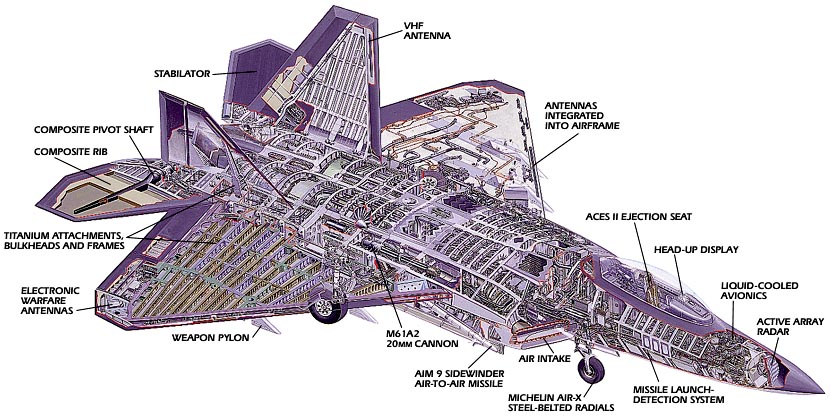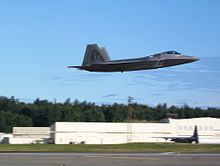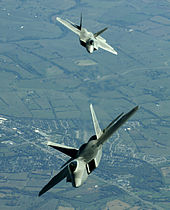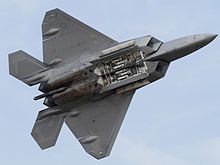
|
Images for Cut away section aircraft 
|
| Airframe |
| Avionics |
| Cockpit |
| Cockpit Picture |
| Engines |
| Features |
| History |
| Interviews |
| Parts Program |
| Radar |
| Specifications Overview |
| Stealth |
| Timeline |
| Training |
| Weapons |
| Ceiling: | 50,000 ft (15,240 m) |
| Crew: | 1 |
| Categories | Fighter Aircraft, Air Force Fighters, Air Force Aircraft, Attack Aircraft, Air Force Attack Aircraft, Military Aircraft, Air Force Equipment |
| Armament | M61A2 cannon; 2x AIM-9 ; 6x AIM-120; 2x GBU-32; 2x AIM-120 |
| Power Plant | Two Pratt & Whitney F119-PW-100 turbofan engines with afterburners and two-dimensional thrust vectoring nozzles. |
| Speed | Mach 2 |
| Engine Thrust Class: | 35,000 lb |
| Engines: | Pratt & Whitney F-119 |
| First Flight: | September 7th 1997 |
| G Limit: | +9 G |
| Horizontal Tail Span: | 29ft |
| Level Speed: | 921 mph |
| Max. Takeoff Weight: | 60,000 lb (27,216 kg) |
| Max. External Stores: | 5,000 lb (2,270 kg) |
| Outer Surface Components: |
 39% Titanium 24% Composite 16% Aluminum 01% Thermo-plastic |
| Total Length: | 62.08 ft |
| Tail Span: | 18'10" |
| Total Height: | 16.67ft |
| Track Width: | 10.6ft |
| Weight Empty: | 31,670 lb (14,365 kg) |
| Wing Area: | 840 sq ft |
| Wing Span: | 44.5 ft |
Images for view a three view diagram of the F-22


F-22A Raptor at 2008 Andrews AFB airshow |

An F-22 during takeoff, at Elmendorf AFB, Anchorage, Alaska |

Two F-22s during flight testing, the upper one being the first EMD F-22, "Raptor 01" |

Two F-22 Raptors line up for refueling during their first official deployment, October 2005 |

Two F-22A Raptors in close trail formation |

F-22 Raptor, Andrews Air Force Base |

An F-22 fires an AIM-120 AMRAAM |

For stealth, the F-22 carries weapons in internal bays. The doors for the center bay and smaller side bays are open showing the six LAU-142/A AMRAAM Vertical Ejection Launchers (AVEL). |

F-22 with external weapons pylons. |

An F-22 refuels from a KC-135 during testing; the attachment on the back top is for a spin recovery chute |

An F-22 observes as an F-15 Eagle banks left. The F-22 is intended to replace the F-15C/D |
| Here are further guidelines. |
|
|
|
The F-22 cannot be matched by any known or projected fighter aircraft. A combination of sensor capability, integrated avionics, situational awareness, and weapons provides first-kill opportunity against threats. The F-22 Raptor possesses a sophisticated sensor suite allowing the pilot to track, identify, shoot and kill air-to-air threats before being detected. Significant advances in cockpit design and sensor fusion improve the pilot's situational awareness. In the air-to-air configuration the Raptor carries six AIM-120 AMRAAMs and two AIM-9 Sidewinders. The F-22 has a significant capability to attack surface targets. In the air-to-ground configuration the aircraft can carry two 1,000-pound GBU-32 Joint Direct Attack Munitions internally and will use on-board avionics for navigation and weapons delivery support. In the future air-to-ground capability will be enhanced with the addition of an upgraded radar and up to eight small diameter bombs. The Raptor will also carry two AIM-120s and two AIM-9s in the air-to-ground configuration. Advances in low-observable technologies provide significantly improved survivability and lethality against air-to-air and surface-to-air threats. The F-22 Raptor brings stealth into the day, enabling it not only to protect itself but other assets. The F-22 engines produce more thrust than any current fighter engine. The combination of sleek aerodynamic design and increased thrust allows the F-22 to cruise at supersonic airspeeds (greater than 1.5 Mach) without using afterburner -- a characteristic known as supercruise. Supercruise greatly expands the F-22 's operating envelope in both speed and range over current fighters, which must use fuel-consuming afterburner to operate at supersonic speeds. The sophisticated F-22 aerodesign, advanced flight controls, thrust vectoring, and high thrust-to-weight ratio provide the capability to outmaneuver all current and projected aircraft. The F-22 Raptor design has been extensively tested and refined aerodynamically during the development process. The F-22's characteristics provide a synergistic effect ensuring F-22A lethality against all advanced air threats. The combination of stealth, integrated avionics and supercruise drastically shrinks surface-to-air missile engagement envelopes and minimizes enemy capabilities to track and engage the F-22 . The combination of reduced observability and supercruise accentuates the advantage of surprise in a tactical environment. The F-22 will have better reliability and maintainability than any fighter aircraft in history. Increased F-22 reliability and maintainability pays off in less manpower required to fix the aircraft and the ability to operate more efficiently. |
